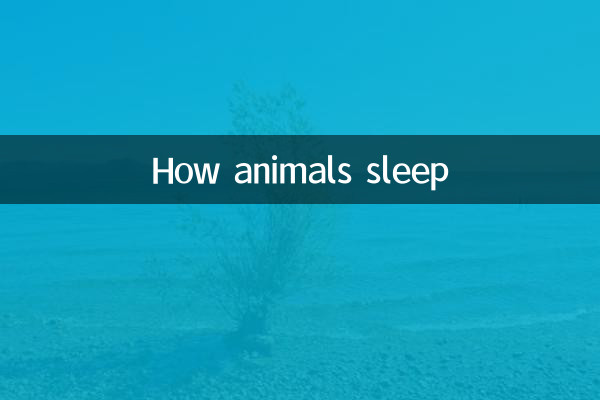How animals sleep
Sleep is an important physiological need for animal survival, and different animals have various ways of sleeping. Some animals sleep for very short periods of time, while others sleep almost all day long. Here are some interesting phenomena and structured data about animal sleep.
1. Comparison of sleep time of animals

| animal name | Average daily sleep duration (hours) | sleep characteristics |
|---|---|---|
| lion | 18-20 | Sleep during the day, active at night |
| giraffe | 1.9-4.6 | Sleep in segments, a few minutes at a time |
| dolphin | 8 | Half the brain sleeps, staying alert |
| bat | 19-20 | sleeping upside down |
| cat | 12-16 | A lot of light sleep, easy to wake up |
2. Unique animal sleeping positions
Different animals have amazing sleeping positions:
| animals | Sleeping position | Reason |
|---|---|---|
| flamingo | stand on one leg | Reduce heat loss |
| sea otter | floating hand in hand | Prevent being washed away by water flow |
| sloth | upside down tree branch | Avoid ground predators |
| penguin | sleep standing up | Escape from danger quickly |
3. Animal sleep cycles
Mammalian sleep cycles are similar to humans and include rapid eye movement sleep (REM) and non-rapid eye movement sleep (NREM). But the length of the cycle varies greatly between animals:
| animals | REM ratio | Sleep cycle length (minutes) |
|---|---|---|
| human | 20-25% | 90 |
| cat | 30% | 30 |
| mouse | 15% | 12 |
| elephant | 5% | 120 |
4. The most sleeping animal
Some animals are known for their amazing ability to sleep:
| Ranking | animals | sleep characteristics |
|---|---|---|
| 1 | koala | Sleep 22 hours a day |
| 2 | brown bat | Sleep 20 hours a day |
| 3 | sloth | Sleep 15-20 hours a day |
| 4 | lion | Sleep 18-20 hours a day |
5. Animals that don’t sleep
Surprisingly, some animals require almost no sleep:
| animals | sleep time | Adaptation mechanism |
|---|---|---|
| giraffe | 2 hours/day | segmented sleep |
| Albatross | Microsleep during flight | half-brain sleep |
| bull frog | not sleeping | always stay alert |
6. Hibernation and aestivation of animals
Some animals enter special hibernation states to cope with extreme environments:
| hibernation type | represent animals | duration |
|---|---|---|
| hibernation | bear, hedgehog | months |
| Aestivation | desert tortoise | weeks |
| Day sleep | hummingbird | every night |
How animals sleep reflects their exquisite adaptations to their environment. From a few seconds of microsleep to months-long hibernation, every sleep strategy is designed to survive in the dangerous nature of nature. Studying animal sleep not only helps us understand the mysteries of nature, but also provides valuable reference for human sleep research.
By comparing the sleep patterns of different animals, we found that sleep time is closely related to body size, food habits, and living environment. Carnivores tend to sleep more than herbivores because their food is more energy dense; animals living in dangerous environments have developed various ways of sleeping to stay alert. These interesting sleep phenomena demonstrate the amazing power of biological evolution.

check the details

check the details